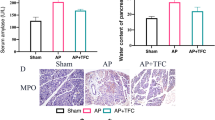Summary
Background. In an attempt to obtain evidence of the beneficial effects of TJ-10, we investigated the gene expression of PAP, an acute phase protein specific for pancreatitis in rat spontaneous chronic pancreatitis.
Methods. Four-wk-old male WBN/Kob rats were fed with MB-3 pellet diet containing herbal medicine. There were two administration groups for each drug: the prophylactic group administered from 4–12 wk, and the therapeutic group administered from 12–20 wk. Untreated control rats were fed with MB-3 alone. Histopathologic changes and PAP gene expressions were analyzed at 12 and 20 wk.
Results. In the prophylactic group, TJ-10-treated WBN/Kob rats showed no evidence of pancreatitis, and there was the amelioration of pancreatitis in the pancreata of the rats treated with other herbal medicines except TJ-24 at 12 wk. PAP mRNA was not expressed in the TJ-10-treated rats, and PAP gene expression was suppressed in rats treated with other drugs except TJ-107. In the therapeutic group, the amelioration of pancreatitis was seen only in TJ-10-treated rats, but PAP gene expression was significantly suppressed in the rats treated with all herbal medicines tested, compared with that in untreated control rats.
Conclusion. An herbal medicine Saiko-keishi-to (TJ-10) delayed the onset of chronic pancreatitis in the WBN/Kob rat, and suppressed the pancreatitis-associated protein (PAP) gene expression more significantly than other herbal medicines.
Similar content being viewed by others
References
Lankisch PG and Banks PA. Chronic pancreatitis: pathology, in Pancreatitis (Lankisch PG and Banks PA, eds.), Springer-Verlag, Berlin 1998; pp. 215–218.
Mori Y, Yokoyama J, Nishimura M, Serizawa O, Ikeda Y. Effect of camostat on pancreatic impairment in WBN/Kob rats. Biomed Res 1989; 10(Suppl 1): 157–166.
Otsuki M, Tani S, Okabayashi Y, Fuji M, Nakamura T, Fujisawa T, Itoh H. Beneficial effects of the synthetic trypsin inhibitor camostate in cerulein-induced acute pancreatitis in rats. Dig Dis Sci 1990; 35: 242–250.
Sugiyama M, Kobori O, Atomi Y, Wada N, Kuroda A, Muto T. Effect of oral administration of protease inhibitor on pancreatic exocrine function in WBN/Kob rats with chronic pancreatitis. Pancreas 1996; 13: 71–79.
Nakata K, Hosono Y, Hosono H, Sakaguchi H, Hosono S. The treatment with Kampo medicine for chronic pancreatitis. Jpn J Orient Med 1986; 36: 25–43 (in Japanese with English abstract).
Wakasugi H. Kampo treatment of chronic pancreatitis. J Clin Exp Med 1993; 67: 824–829 (in Japanese).
Su S-B, Motoo Y, Xie M-J, Sakai J, Taga H, Sawabu N. Expression of pancreatitis-associated protein (PAP) in spontaneous chronic pancreatitis in the WBN/Kob rat: effect of herbal medicine Saiko-keishi-to (TJ-10). Pancreas 1999; 19: 239–247.
Ohashi K, Kim JH, Hara H, Aso R, Akimoto T, Narama K. WBN/Kob rats, a new spontaneously occurring model of chronic pancreatitis. Int J Pancreatol 1990; 6: 231–247.
Arai I, Hasegawa M, Mase A, Kitani T, Komatsu Y, Yamaura H, et al. Development of pancreatic dysfunction and pathohistology in WBN/Kob rats using special breeding diet. Jpn J Appl Physiol 1997; 27: 373–380.
Itoh T, Teraoka H. Cloning and tissue-specific expression of cDNAs for the human and mouse homologues of rat pancreatitis-associated protein (PAP). Biochem Biophys Acta 1993; 1172: 184–186.
Keim V, Iovanna JL, Dagorn J-C. The acute phase reaction of the exocrine pancreas: gene expression and synthesis of pancreatitis-associated proteins. Digestion 1994; 55: 65–72.
Iovanna JL, Keim V, Nordback I, et al. Serum levels of pancreatitis-associated protein as indicators of the course of acute pancreatitis. Gastroenterology 1994; 106: 728–734.
Motoo Y, Satomura Y, Mouri I, et al. Serum levels of pancreatitis-associated protein in digestive diseases with special reference to gastrointestinal cancers. Dig Dis Sci 1999; 44: 1142–1147.
Sparmann G, Merkord J, Jaschke A, et al. Pancreatic fibrosis in experimental pancreatitis induced by dibutyltin dichloride. Gastroenterology 1997; 112: 1664–1672.
Kataoka K, Sasaki T, Yorizumi H, Sakagami J, Kashima K. Pathophysiologic studies of experimental chronic pancreatitis in rats induced by injection of zein-oleic acid-linoleic acid solution into the pancreatic duct. Pancreas 1998; 16: 289–299.
Yamamoto M, Kumagai A, Yamamura Y. Structure and actions of saikosaponins isolated from Bupleurum falcatum L. I. Anti-inflammatory action of saikosaponins. Arzneimittelforschung 1975; 25: 1021–1023.
Zhou ZC, Wang GZ, Ma JL. The anti-allergic inflammation action of saikosaponins. J Tradit Chin Med 1983; 3: 103–112.
Shiratori K, Watanabe S, Takeuchi T. Effect of licorice extract (Fm 100) on release of secretin and exocrine pancreatic secretion in humans. Pancreas 1986; 1: 483–487.
Takahashi S, Yoshikawa T, Naito Y, Minamiyama Y, Tanigawa T, Kondo M. Antioxidant properties of anti-ulcer Kampo medicines. Free Radic Res Commun 1993; 19(Suppl 1): S101-S108.
Kim YH, Park KH, Rho HM. Transcriptional activation of the Cu, Zn-superoxide dismutase gene through the AP2 site by ginsenoside Rb2 extracted from a medicinal plant, Panax ginseng. J Biol Chem 1996; 271: 24,539–24,543.
Fan ZH, Isobe K, Kiuchi K, Nakashima I. Enhancement of nitric oxide production from activated macrophages by a purifued form of ginsenoside (Rg1). Am J Chin Med 1995; 23: 279–287.
Author information
Authors and Affiliations
Corresponding author
Rights and permissions
About this article
Cite this article
Motoo, Y., Su, SB., Xie, MJ. et al. Effect of herbal medicine Saiko-Keishi-to (TJ-10) on rat spontaneous chronic pancreatitis. International Journal of Pancreatology 27, 123–129 (2000). https://doi.org/10.1385/IJGC:27:2:123
Received:
Revised:
Accepted:
Issue Date:
DOI: https://doi.org/10.1385/IJGC:27:2:123




